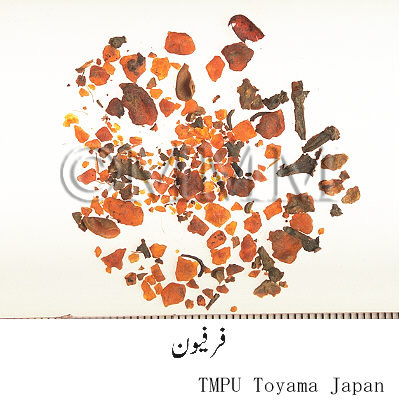Crude drug sample data base
※Click on the image to enlarge it.
The capital city, provincial capital city or the representative
location of its administrative area is indicated.
location of its administrative area is indicated.
Production area information
https://ethmed.toyama-wakan.net/img/pin_san.png
23.810332
90.41251809999994
Collection information
People's Republic of Bangladesh,Dacca [Dhaka]
https://ethmed.toyama-wakan.net/img/pin_nyu.png
Scientific information data base
| Crude drug name | Urudu name, English name | Farfiyun, Gum euphorbium | ||
|---|---|---|---|---|
| Arabic name / Persian name | Akl-banafsah, Farbiyun / Akarbiyun | |||
| crude drug image |
| |||
| Original plant name | Euphorbia resinifera Berg. | |||
| Family name | Euphorbiaceae | |||
| Used part | Gum | |||
| Distribution area | It is a native of Morocco. Not found in India and Pakistan. | |||
| Description | The drug is the dried milk of which is the gum Euphorbium and known in Indian Bazaars as Farbiyun. When fresh it is yellow translucent and easily soluble in olive oil; when old it turns reddish yellow and the odour is acrid. Not soluble in olive oil. Taste - bitter. Its potency is altered after three or four years of storage. The kind of gum euphorbium which is fresh, pure, yellowish red, intensely odorous and most pungent is considered good. Some other available varieties are adulterated with sarcocolla and other gums (Avicenna). | |||
| Function and properties | Joints, Eye, Excretion. Detergent, attenuant, possesses the burning and cleansing properties. Fresh variety is hotter than asafoetida (no gum can be matched with asafoetida in warming property). It provides warmth and strengthens the nerves / muscles. If used internally it causes watery motion. | |||
| Specific actions | Antiphlegmatic and useful in nervous disorders. | |||
| Frequency in use | Not found in India. | |||
| Common uses | Joints: It is used with some aromatic syrups in cases of sciatica. It is very useful when smeared on the organs affected by paralysis and loss of sensation. It is massaged on affected organs with olive oil in facial paralysis, hemilpegia, rheumatism, trembling; removes phlegmatic humours from the joints and limbs. Eye: It is applied as a collyrium, it acts as a detergent and also removes bluish secretions form the eye. It is used with honey in all kinds of medicines for the eye (cataract). Excretion: It is useful in removing yellow water and coldness of the kidneys. It is useful also for colic patients. According to Khuzi the gum euphorbium evacuates the viscous phlegm already accumulated in the regions of hips, back and intestines. It is used as an enema in obstructed menses. As aphrodisiac it is used with other medicines. | |||
| Side effect | This protects from ill effects of the bites of snake or an insect. A dose of 10.5gm. of euphorbium taken orally for three days becomes fatal by causing ulcers in stomach and intestines. | |||
| Medical system | Unani | |||
| Traditional concept | Temperament | It is hot and dry in the fourth degree. | ||
| Drug effect | It is antiphlegmatic. It acts as beneficial curative of all types of nervous diseases. It is harmful for intestines, uterus and testicles. | |||
| Dosage | 250 to 500 mg. | |||
| Substitute | Mazriun (Clitoria ternatea Linn.) for dropsy and Jundbidastar (castoreum) for colic. | |||
| Related drugs | Euphorbia antiquorum Linn. It is found in India. | |||
| Corrigent (corrective) | Goggul (Commiphora mukul Engl.) and Mulaithi (Glycyrrhiza glabra Linn.). | |||
| References | Reference book Tips! | Indian Medicinal Plants (Second Edition), Vols. 1-5, 1993. Kirtikar, K.R. and Basu. B.D., Periodical Experts Book Agency, Delhi p 114. Indian Materia Medica, Vols. 1-2, 1976 (Repr. 1989). Nadkarni, A.K., Popular Prakashan Pvt. Ltd., Bombay Vol. 1, p 528. Makhzanul-Mufradat (Khawasul Adviyah), Hakeem Kabiruddin, Daftar Al-Masih, Qarol Bagh, Delhi. pp 413-414. Al-Qanun Fil-Tibb. Avicenna. (English translation of the critical Arabic text), Book 2, 1998. Hameed, H. A. (editor), Dept. of Islamic Studies, Jamia Hamdard (Hamdard University), New Delhi. pp 345-346. Al-Jamili Mufradt Al Adwiya Wal Aghziya (1197-1248 A.D.). Ibn al-Baytar. Vols. 1-3, 1985-1999. Central council for Research in Unani Medicine, Janakpuri, New Delhi. pp 359-362. | ||
| Remarks | According to Ibn al-Baytar its corrective is Katira (Cochlospermum religiosum (L.) Alston) and oil of sweet almond. Its higher dose (50mg.) is fatal . Its side effects are pain in abdomen, restlessness and shrinking of stomach. It may also cause abortion. It is described as a very strong drug by all Unani physicians. Its potency can be preserved upto four years. It becomes inert between seven and ten years at its shelflife. It is mainly used with oils i.e. saussurea oil, olive oil, aromatic syrups and honey. It is not suitable for individulals who are having hot temperament and plethoric. It is not taken alone as it is harmful for lower intestines. | |||
| Last renewal date | 2024/03/11 | |||



